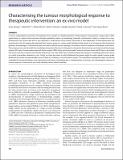Files in this item
Characterising the tumour morphological response to therapeutic intervention : an ex vivo model
Item metadata
| dc.contributor.author | Savage, Anne | |
| dc.contributor.author | Katz, Elad | |
| dc.contributor.author | Eberst, Alistair | |
| dc.contributor.author | Falconer, Ruth E. | |
| dc.contributor.author | Houston, Alasdair | |
| dc.contributor.author | Harrison, David J. | |
| dc.contributor.author | Bown, James | |
| dc.date.accessioned | 2014-07-22T10:01:01Z | |
| dc.date.available | 2014-07-22T10:01:01Z | |
| dc.date.issued | 2013-01 | |
| dc.identifier | 134411588 | |
| dc.identifier | 2f267684-0779-4092-bb20-63296ee1845a | |
| dc.identifier | 000314865700024 | |
| dc.identifier | 84872069403 | |
| dc.identifier.citation | Savage , A , Katz , E , Eberst , A , Falconer , R E , Houston , A , Harrison , D J & Bown , J 2013 , ' Characterising the tumour morphological response to therapeutic intervention : an ex vivo model ' , Disease Models & Mechanisms , vol. 6 , no. 1 , pp. 252-260 . https://doi.org/10.1242/dmm.009886 | en |
| dc.identifier.issn | 1754-8403 | |
| dc.identifier.other | ORCID: /0000-0001-9041-9988/work/64034306 | |
| dc.identifier.uri | https://hdl.handle.net/10023/5059 | |
| dc.description | This work was supported by the Northwood Trust (A.S., A.E., J.B.), the Scottish Alliance for Geoscience, Environment and Society (R.F.) and Scottish Funding Council (D.J.H.). | en |
| dc.description.abstract | In cancer, morphological assessment of histological tissue samples is a fundamental part of both diagnosis and prognosis. Image analysis offers opportunities to support that assessment through quantitative metrics of morphology. Generally, morphometric analysis is carried out on two-dimensional tissue section data and so only represents a small fraction of any tumour. We present a novel application of three-dimensional (3D) morphometrics for 3D imaging data obtained from tumours grown in a culture model. Minkowski functionals, a set of measures that characterise geometry and topology in n-dimensional space, are used to quantify tumour topology in the absence of and in response to therapeutic intervention. These measures are used to stratify the morphological response of tumours to therapeutic intervention. Breast tumours are characterised by estrogen receptor (ER) status, human epidermal growth factor receptor (HER) 2 status and tumour grade. Previously, we have shown that ER status is associated with tumour volume in response to tamoxifen treatment ex vivo. Here, HER2 status is found to predict the changes in morphology other than volume as a result of tamoxifen treatment ex vivo. Finally, we show the extent to which Minkowski functionals might be used to predict tumour grade. Minkowski functionals are generalisable to any 3D data set, including in vivo and cellular systems. This quantitative topological analysis can provide a valuable link among biomarkers, drug intervention and tumour morphology that is complementary to existing, non-morphological measures of tumour response to intervention and could ultimately inform patient treatment. | |
| dc.format.extent | 9 | |
| dc.format.extent | 545882 | |
| dc.language.iso | eng | |
| dc.relation.ispartof | Disease Models & Mechanisms | en |
| dc.subject | Primary breast-cancer | en |
| dc.subject | Term-follow-up | en |
| dc.subject | Minkowski functionals | en |
| dc.subject | 3-dimensional culture | en |
| dc.subject | Colorectal-cancer | en |
| dc.subject | Fractal dimension | en |
| dc.subject | Sensitivity | en |
| dc.subject | Expression | en |
| dc.subject | Survival | en |
| dc.subject | Tissue | en |
| dc.subject | R Medicine (General) | en |
| dc.subject | SDG 3 - Good Health and Well-being | en |
| dc.subject.lcc | R1 | en |
| dc.title | Characterising the tumour morphological response to therapeutic intervention : an ex vivo model | en |
| dc.type | Journal article | en |
| dc.contributor.institution | University of St Andrews. School of Medicine | en |
| dc.identifier.doi | 10.1242/dmm.009886 | |
| dc.description.status | Peer reviewed | en |
| dc.identifier.url | http://dmm.biologists.org/content/6/1/252/suppl/DC1 | en |
This item appears in the following Collection(s)
Items in the St Andrews Research Repository are protected by copyright, with all rights reserved, unless otherwise indicated.

